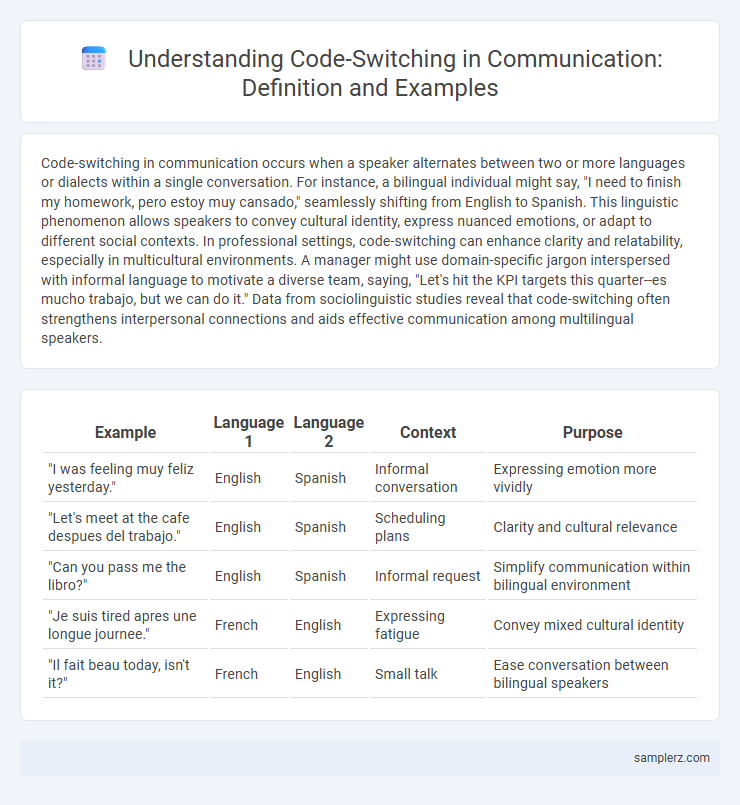Code-switching in communication occurs when a speaker alternates between two or more languages or dialects within a single conversation. For instance, a bilingual individual might say, "I need to finish my homework, pero estoy muy cansado," seamlessly shifting from English to Spanish. This linguistic phenomenon allows speakers to convey cultural identity, express nuanced emotions, or adapt to different social contexts. In professional settings, code-switching can enhance clarity and relatability, especially in multicultural environments. A manager might use domain-specific jargon interspersed with informal language to motivate a diverse team, saying, "Let's hit the KPI targets this quarter--es mucho trabajo, but we can do it." Data from sociolinguistic studies reveal that code-switching often strengthens interpersonal connections and aids effective communication among multilingual speakers.
Table of Comparison
| Example | Language 1 | Language 2 | Context | Purpose |
|---|---|---|---|---|
| "I was feeling muy feliz yesterday." | English | Spanish | Informal conversation | Expressing emotion more vividly |
| "Let's meet at the cafe despues del trabajo." | English | Spanish | Scheduling plans | Clarity and cultural relevance |
| "Can you pass me the libro?" | English | Spanish | Informal request | Simplify communication within bilingual environment |
| "Je suis tired apres une longue journee." | French | English | Expressing fatigue | Convey mixed cultural identity |
| "Il fait beau today, isn't it?" | French | English | Small talk | Ease conversation between bilingual speakers |
Understanding Code-Switching in Everyday Communication
Code-switching occurs when bilingual or multilingual speakers alternate between languages or dialects within a conversation, often to express identity or accommodate their audience. It serves as a strategic communicative tool that enhances clarity, strengthens social bonds, and navigates cultural nuances. Understanding code-switching in everyday communication reveals its role in cognitive flexibility and social adaptability across diverse linguistic contexts.
Code-Switching in Multilingual Workplaces
Code-switching in multilingual workplaces often occurs when employees alternate between languages to clarify concepts, build rapport, or accommodate diverse colleagues. For example, a bilingual employee might switch from English to Spanish during a team meeting to ensure precise understanding among Spanish-speaking members. This practice enhances communication effectiveness and fosters an inclusive work environment.
Code-Switching Among Friends: Casual Conversations
Code-switching among friends often occurs during casual conversations where speakers alternate between languages or dialects to express identity or shared cultural background. This practice enhances camaraderie and humor, allowing individuals to convey nuanced meanings or inside jokes. Studies reveal that code-switching in informal settings strengthens social bonds and facilitates more dynamic and engaging interactions.
Educational Settings: Teachers and Student Code-Switching
Teachers and students often engage in code-switching in educational settings to enhance understanding and cultural connection. For instance, a bilingual teacher might alternate between English and Spanish to clarify complex concepts, making lessons more accessible for multilingual students. This strategic use of code-switching supports cognitive development and fosters an inclusive classroom environment.
Family Communication: Code-Switching Across Generations
In family communication, code-switching often occurs as younger members alternate between languages or dialects to connect with both peers and older relatives, reflecting cultural identity and generational shifts. This practice facilitates understanding and emotional bonding, especially in bilingual households where language preferences differ across generations. Studies show that code-switching within families serves as a dynamic tool for negotiating social roles and preserving heritage languages.
Media and Pop Culture References to Code-Switching
In media and pop culture, code-switching often appears in television shows and music where characters or artists seamlessly shift between languages to reflect cultural identity or social context. TV series like "Black-ish" and "Jane the Virgin" showcase code-switching as a natural part of dialogue, enhancing authenticity and relatability for bilingual audiences. Music genres such as hip-hop and reggaeton frequently incorporate code-switching to blend linguistic styles, appeal to diverse listeners, and express multicultural heritage.
Digital Communication: Code-Switching on Social Media
Code-switching on social media occurs when users alternate between languages, dialects, or registers within posts or comments to convey identity or emotion effectively. Platforms like Twitter and Instagram showcase frequent shifts between English and regional languages, enhancing relatability and engaging diverse audiences. This linguistic flexibility fosters inclusive digital communication, strengthening community bonds across cultural boundaries.
Professional Networking and Business Code-Switching
In professional networking, code-switching often involves alternating between formal business language and industry-specific jargon to establish credibility and foster rapport. Business code-switching includes adjusting tone and vocabulary to suit diverse corporate cultures, enhancing clarity and mutual understanding. Mastery of this linguistic adaptability facilitates effective communication across hierarchical levels and international markets.
Cultural Identity and Code-Switching
Code-switching exemplifies how individuals navigate cultural identity by alternating between languages or dialects within a conversation to express belonging and cultural nuance. This practice reinforces social bonds and signals in-group membership, reflecting the dynamic nature of personal and collective identity in multilingual communities. Cultural identity is thus both preserved and adapted through strategic language shifts that convey solidarity, respect, or situational appropriateness.
Code-Switching Challenges and Strategies in Communication
Code-switching in communication presents challenges such as misinterpretation and social stigma when speakers alternate between languages or dialects within a conversation. Effective strategies to overcome these challenges include developing cultural sensitivity, using context-aware language cues, and fostering inclusive environments that respect linguistic diversity. Training in pragmatic competence and promoting awareness of code-switching's communicative functions can enhance understanding and reduce communication barriers.

example of code-switching in communication Infographic
 samplerz.com
samplerz.com